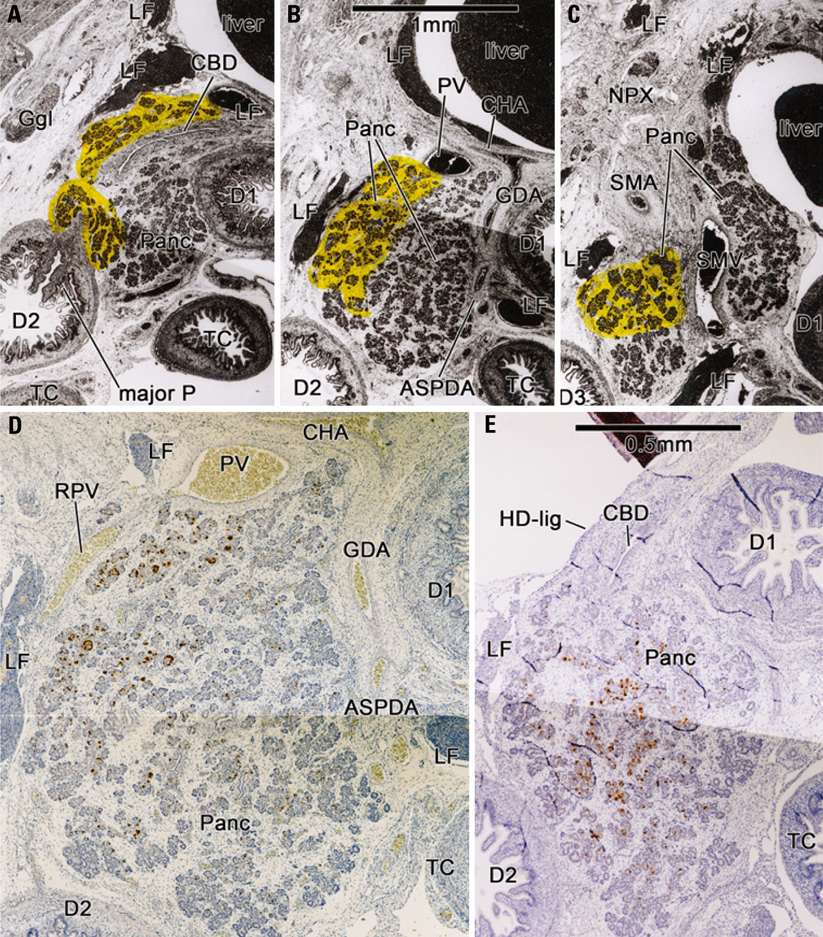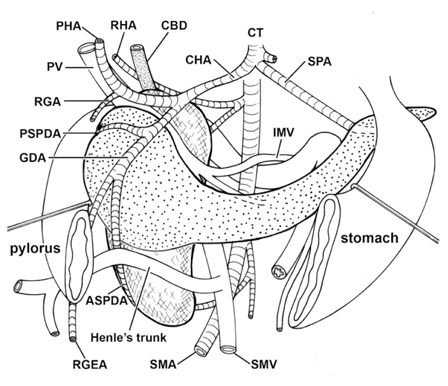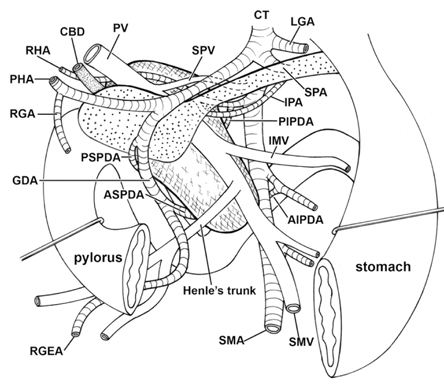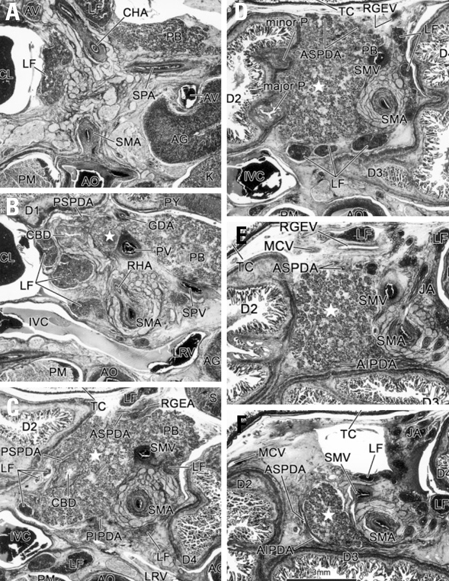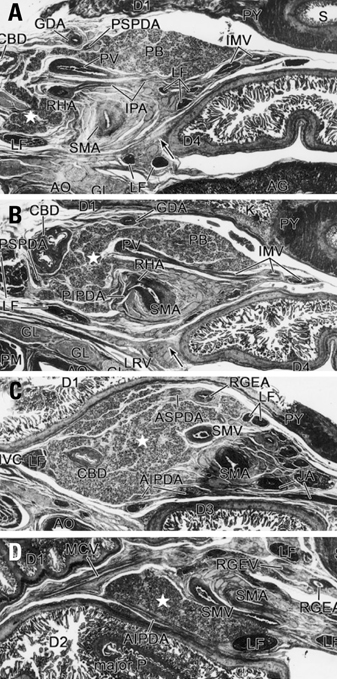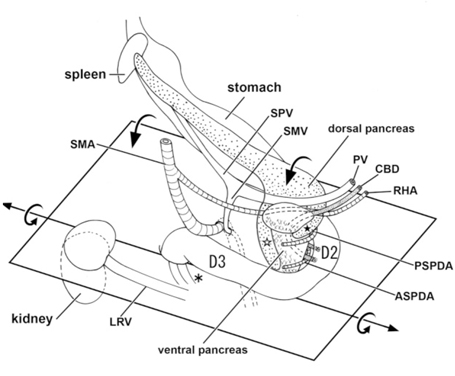Yonsei Med J.
2010 May;51(3):398-406. 10.3349/ymj.2010.51.3.398.
Fetal Topographical Anatomy of the Pancreatic Head and Duodenum with Special Reference to Courses of the Pancreaticoduodenal Arteries
- Affiliations
-
- 1Departement of Surgery, Chonbuk National University Medical School, Jeonju, Korea. hcyu@chonbuk.ac.kr
- 2Departement of Anatomy, Chonbuk National University Medical School, Jeonju, Korea.
- 3Departement of Gastroenterologic Surgery, Yamagata University School of Medicine, Yamagata, Japan.
- 4Departement of Anatomy, Sapporo Medical University School of Medicine, Sapporo, Japan.
- 5Division of Internal Medicine, Iwamizawa Koujin-kai Hospital, Iwamizawa, Japan.
- KMID: 1074992
- DOI: http://doi.org/10.3349/ymj.2010.51.3.398
Abstract
- PURPOSE
The purpose of this study is to provide better understanding as to how the "double" vascular arcades, in contrast to other intestinal marginal vessels, develop along the right margin of the pancreatic head.
MATERIALS AND METHODS
In human fetuses between 8-30 weeks, we described the topographical anatomy of the vessels, bile duct, duodenum as well as the ventral and dorsal primordia of the pancreatic head with an aid of pancreatic polypeptide immunohisto-chemistry.
RESULTS
The contents of the hepatoduodenal ligament crossed the superior side of the pylorus. Moreover, the right hepatic artery originating from the superior mesenteric artery ran along the superior aspect of the pancreatic head. An arterial arcade, corresponding to the posterior pancreaticoduodenal arteries, encircled the superior part of the pancreatic head, whereas another arcade, corresponding to the anterior pancreaticoduodenal arteries, surrounded the inferior part. The dorsal promordium of the pancreas surrounded and/or mixed the ventral primordium at 13-16 weeks. Thus, both arterial arcades were likely to attach to the dorsal primordium.
CONCLUSION
The fetal anatomy of the pancreaticoduodenal vascular arcades as well as that of the hepatoduodenal ligament were quite different from adults in topographical relations. Thus, in the stage later than 30 weeks, further rotation of the duodenum along a horizontal axis seemed to be required to move the pylorus posterosuperiorly and to reflect the superior surface of the pancreatic head posteriorly. However, to change the topographical anatomy of the superior and inferior arterial arcades into the final position, re-arrangement of the pancreatic parenchyma might be necessary in the head.
Keyword
MeSH Terms
Figure
Reference
-
1. Bertelli E, Di Gregorio F, Bertelli L, Mosca S. The arterial blood supply of the pancreas: a review. I. The superior pancreaticoduodenal and the anterior superior pancreaticoduodenal arteries. An anatomical and radiological study. Surg Radiol Anat. 1995. 17:97–106. 1–3.2. Bertelli E, Di Gregorio F, Bertelli L, Civeli L, Mosca S. The arterial blood supply of the pancreas: a review. II. The posterior superior pancreaticoduodenal artery. An anatomical and radiological study. Surg Radiol Anat. 1996. 18:1–9.3. Murakami G, Hirata K, Takamuro T, Mukaiya M, Hata F, Kitagawa S. Vascular anatomy of the pancreaticoduodenal region: a review. J Hepatobiliary Pancreat Surg. 1999. 6:55–68.
Article4. Sakamoto Y, Nagai M, Tanaka N, Nobori M, Tsukamoto T, Nokubi M, et al. Anatomical segmentectomy of the head of the pancreas along the embryological fusion plane: a feasible procedure? Surgery. 2000. 128:822–831.5. Paulin C, Dubois PM. Immunohistochemical identification and localization of pancreatic polypeptide cells in the pancreas and gastrointestinal tract of the human fetus and adult man. Cell Tissue Res. 1978. 188:251–257.
Article6. Rahier J, Wallon J, Gepts W, Haot J. Localization of pancreatic polypeptide cells in a limited lobe of the human neonate pancreas: remnant of the ventral primordium? Cell Tissue Res. 1979. 200:359–366.
Article7. Tadokoro H, Kozu T, Toki F, Kobayashi M, Hayashi N. Embryological fusion between the ducts of the ventral and dorsal primordia of the pancreas occurs in two manners. Pancreas. 1997. 14:407–414.
Article8. Uchida T, Takada T, Ammori BJ, Suda K, Takahashi T. Three-dimensional reconstruction of the ventral and dorsal pancreas: a new insight into anatomy and embryonic development. J Hepatobiliary Pancreat Surg. 1999. 6:176–180.9. Takada T. Vantral pancreatectomy: resection of the ventral segment of the pancreas. J Hepatobiliary Pancreat Surg. 1993. 1:36–40.10. Ryu M, Takayama W, Watanabe K, Honda I, Yamamoto H, Arai Y. Ventral pancreatic resection for adenoma and low-grade malignancies of the head of the pancreas. Surg Today. 1996. 26:476–481.11. Takahashi S, Akita K, Goseki N, Sato T. Spatial arrangement of the pancreatic ducts in the head of the pancreas with special reference to the branches of the uncinate process. Surgery. 1999. 125:178–185.12. Kamisawa T, Egawa N, Tu Y, Tsuruta K, Okamoto A. Pancreatographic investigation of embryology of complete and incomplete pancreas divisum. Pancreas. 2007. 34:96–102.13. Michels NA. Blood supply and anatomy of the upper abdominal organs with a descriptive atlas. 1955. Philadelphia: Lippincott;24–133.14. Adda G, Hannoun L, Loygue J. Development of the human pancreas: variations and pathology. A tentative classification. Anat Clin. 1984. 5:275–283.15. Krakowiak-Sarnowska E, Flisiñski P, Szpinda M, Flisiński M, Sarnowski J. The pancreaticodudenal arteries in human foetal development. Folia Morphol (Warsz). 2004. 63:281–284.16. Skandalakis JE, Gray SW. Embryology for surgeons: the embryological basis for the treatment of congenital anomalies. 1994. Baltimore: Williams & Wilkins;396–404.17. Lee SD, Kim CY, Cho YH, Fujiwara D, Murakami G, Mutsumura H, et al. Morphometrical data of size and shape of the late-stage human fetal liver, including those of intrahepatic vessels: some prenatal and postnatal developmental consideration. Korean J Hepatobiliary Pancreat Surg. 2003. 7:12–18.18. Kanagasuntheram R. Some observations on the development of the human duodenum. J Anat. 1960. 94:231–240.19. Kimura W, Nagai H. Study of surgical anatomy for duodenum-preserving resection of the head of the pancreas. Ann Surg. 1995. 221:359–363.
Article20. Furukawa H, Iwata R, Moriyama N, Kosuge T. Blood supply to the pancreatic head, bile duct, and duodenum: evaluation by computed tomography during arteriography. Arch Surg. 1999. 134:1086–1090.
- Full Text Links
- Actions
-
Cited
- CITED
-
- Close
- Share
- Similar articles
-
- Vascular Anatomy of the Pancreaticoduodenal Region
- Duodenum-preserving Pancreatic Head Resection for Benign Pancreatic Head Lesion
- Pancreatic Head Resection with Segmental Duodenectomy
- Experiences with Pancreaticoduodenal Injuries at a Single Institute
- Topographical Morphology of the Lingual Artery in Korean


